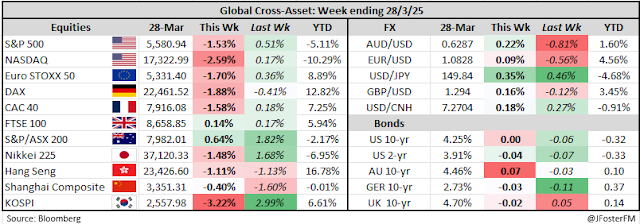Equities were broadly heavy this week with President Trump's announcement of 25% auto tariffs coming ahead of the April 2 'liberation day' where Trump will outline the tariffs the US will impose on a reciprocal basis with its trading partners. Markets were minded to take equities lower and put modest bids into the dollar and Treasurys. In Australia, the 10-year yield went against the tide moving higher as the Federal budget prompted increased issuance plans for 2025/26.
US inflation moving in the wrong direction rattled sentiment during Friday ahead of the widely expected price impacts of tariffs. The core PCE deflator - the Fed's preferred inflation measure - came in firm relative to expectations in February at 0.4%m/m and 2.8%yr, rising from a prior reading of 2.7%. The report also showed that consumer spending was softer than expected rising by 0.4%m/m and 0.1%m/m in nominal and real terms respectively, speaking to nervousness over the US growth outlook. At the recent March policy meeting, the Fed held a cautious line around further rate cuts and with Chair Powell due to speak next week, markets will look for any shift in this narrative.
In the UK, the government avoided its Spring Statement from becoming a market event. The DMO's remit for gilt issuance in 2025/26 came in just below GBP300bn, broadly in line with expectations. The high-tax and spend budget handed down last October left Chancellor Reeves with a minimal GBP9.9bn of headroom with which to keep the budget on track to return to balance by the end of the decade - as required by the fiscal rules. But with weaker growth and higher yields subsequently eroding all of that buffer, the Chancellor has had to recalibrate plans.
For now, spending cuts have been pushed back and tax increases avoided; instead, policy changes are being relied upon to boost growth in order to balance the books. The OBR evaluated the overall effects of those measures to improve the budget position by GBP14bn by 2029/30, restoring the Chancellor's headroom to GBP9.9bn. However, with the state of UK finances remaining finely balanced into what the OBR described as 'risky outlook', markets see tougher decisions on the horizon. The threat of tax rises is keeping prospects for further BoE rate cuts in play, with around 50bps of easing priced into the curve by year-end. That was supported this week by positive surprises on inflation readings in February as headline CPI (0.4%m/m) eased from 3.0% to 2.8%yr and the core rate (0.4%m/m) softened from 3.7% to 3.5%yr.
No change is expected from the RBA next week given its cautious messaging that accompanied its February rate cut. Data since then has been inconclusive, including February's noisy 53k decline in employment, and while the monthly CPI series this week indicated disinflation progress was continuing in early 2025 - headline CPI eased from 2.5% to 2.4%yr and underlying inflation softened to 2.7%yr in February (see here) - the RBA will wait for the more comprehensive quarterly report. That sets the stage for a live policy meeting on 19-20 May.
Budget 2025/26 reaffirmed the outlook for fiscal deficits in Australia to run in the order of 1-1.5% of GDP over the coming years. Structural pressures from rising costs in key areas of government spending and policy choices are key drivers of these deficits, but their ultimate scale will largely depend upon how the highly uncertain economic outlook resolves. With the deficit forecast to widen from $27.6bn to $42.1bn in 2025/26, the AOFM has raised its bond issuance target to $150bn from $100bn in the current financial year.
New announcements in the budget were targeted at the cost of living in the lead-up to the May 3 election. Revenue upgrades have provided the government with $12bn of fiscal headroom to announce modest tax relief and an extension of energy bill rebates as the centrepieces of a $7.2bn package of measures to effect in 2025/26. Treasury forecasts the measures will support a rise in the growth outlook from 1.5% to 2.25% in 2025/26; while the extension of the rebates delays the rise in energy bills, pushing back the increase in headline inflation to 3% into 2025/26. For more analysis, please see my detailed review of Budget 2025/26 here.

